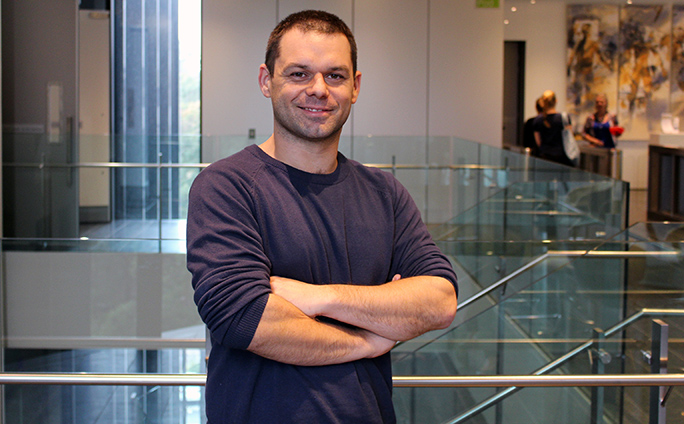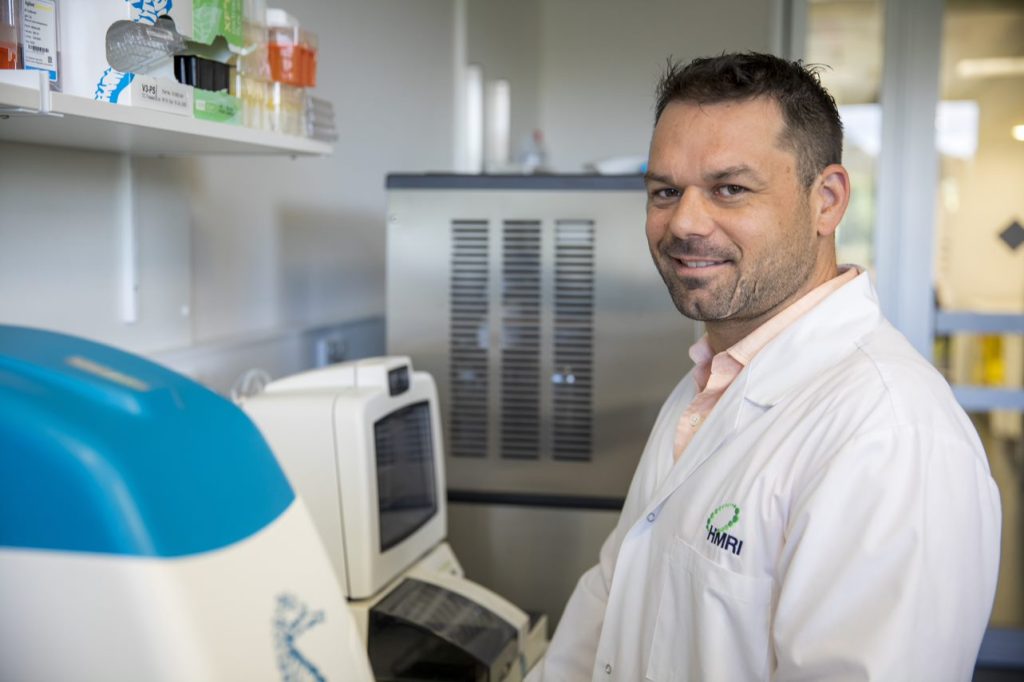Hierarchy can be a scaffold for career growth or a harness that holds back creative thinking.

When staff and co-workers are engaged and given the freedom to be creative, team leaders build loyalty, groups build efficiencies and great things can happen.
Employees who operate in human-centric work models – where they are seen as people, not just resources – are 3.8 times more likely to be high performing, according to a survey by Gartner.
At the Hunter Medical Research Institute (HMRI), one Associate Professor is experimenting with how the management of his lab team can make a difference to outcomes, both for the people and the research.
Jay Horvat is an Associate Professor in Immunology and Microbiology working for HMRI at the University of Newcastle with a focus on investigation and therapeutic targeting of infection and inflammation-induced diseases of the respiratory, reproductive and gastrointestinal tracts and of the central nervous system. His major focus is on asthma and respiratory diseases. HMRI is a medical research institute operating in partnership between the University of Newcastle, and the Hunter New England Local Health District and the community.
Professor Horvat’s leadership style is different to how many lab research projects are run. “I made the decision about three years ago to get the people working with me to be working at my level, my co-leads of the group. The PhD students run their own projects and it means it is a very flat way in which we run the group.”
Human-centric work models encompass three guiding pillars: flexible work experiences, intentional collaboration and empathy-based management.
The Gartner study found that intentional collaboration increases the likelihood of high employee performance by 2.9 times, compared with just 1.6 times for even the best performing location model. Giving workers autonomy over how they work and how they achieve desired outcomes also reduces workers’ fatigue by 1.9 times – critical for sustaining performance over time – and increases employee loyalty.

“There are many ways to run a lab,” says Professor Horvat. “A Principal Investigator can be the head of the lab with everyone else doing all the work and the PI taking all the credit for the work. They are basically the figure head that does all the communicating with external collaborators, they will take all the credit for the work that comes out of the lab.
“I worked in labs where I did a lot of the back ground work, came up with ideas, helped write the grants to secure funding, did the work to generate all the preliminary data in order to make the group successful without necessarily getting credit for it. What you find is if that lab head goes elsewhere, or retires or doesn’t want to work with you anymore, you are essentially stuck because the track record they have is your track record.”
By running his lab with a flat hierarchical structure, the workers get the credit for the work they do as part of the collective within the group.
“External collaborators are going to them and talking to them about that work. If they do a publication, or get a grant, that is their grant, their publication, as far as their track record is concerned,” he explains. “They become known in the field for their accomplishments and being able to run your own research, because ultimately that is how you gain further employment, how you climb the employment ladder.”
How can this help business?
Professor Horvat admits it might not work to keep a big group together, but from the point of view of the research lab, he says, “I’m hoping that the people I work with become successful in their own right, and that we work together as a collective, with no actual lead, but more or less just working together in a collaborative environment where we can share resources.”
And it’s working to a certain degree, he says. One of the post-doctoral researchers received a $1.1 million grant with a collaborator outside of the group. Half that money will come to Newcastle Uni. Resources are being shared and a PhD student on the post-doctoral research project won a career development award to go to Queen’s University in Belfast to learn new techniques with some of the collaborators. It’s not the post-doctoral researcher going, but the PhD student, because of the flat leadership approach and the importance placed on collaborative learning.
Shared resources mean cost savings. It costs a lot of money to hire support people such as research assistants and lab managers. A larger group working together means everyone can contribute some of their resources to looking after those people. It also takes a lot of time to train PhD students, Honours students, Undergraduate research students, so the time resources can be shared across the group. Buying reagents and consumables in bulk is another way the approach contributes to cost efficiencies.
In business, the costs of hiring and training staff continue to be a growing concern. “Rising inflation, scarce expensive talent, and global supply constraints represent a new combination of variables for HR leaders to understand as they consider their 2023 strategies,” said Mark Whittle, vice president of advisory in the Gartner HR practice.
Creating career paths in today’s environment includes providing employees with the ability to experience other career options, sharing diverse colleague examples to show many routes to career progression and offering channels for employees to create best-fit careers.
“HR leaders must design careers and mobility more like navigation systems, which dynamically inform drivers of new preferred routes, obstacles to avoid, and choices between fastest- and most fuel-efficient routes,” added Whittle.
These are some of the techniques Professor Horvat has introduced over the past three years’ in the lab. Some lab heads work in silos and closet their students, their research, and their information in a secretive way, but Horvat says his approach is more open and collaborative and ultimately, he thinks, better for the students.
“They are trying to carve out their own careers. It’s important they can share the information they have, collaborate with other researchers. That is the best way for them to gain employment when they are done.”
One PhD student is currently working for AstraZeneca and another has been taken on at the US Ivy League University of Pennsylvania, setting up a lab using the techniques Horvat uses. He was already, with permission, sharing some of the work he was doing. Another is at Stanford University in California, employed because he was able to share unpublished work with the lab, knowing that they work on similar research.
“It’s more about the students having a successful career, rather than hiding the data that we might have for a short time.”
The proof will be in the pudding, he says, as to whether his management techniques pay dividends. He says he doesn’t have difficulty getting students.